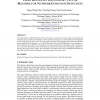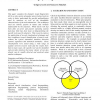708 search results - page 39 / 142 » On the Use of Word Networks to Mimicry Attack Detection |
DSN
2002
IEEE
14 years 17 days ago
2002
IEEE
A masquerade attack, in which one user impersonates another, can be the most serious form of computer abuse. Automatic discovery of masqueraders is sometimes undertaken by detecti...
IWSOS
2007
Springer
14 years 1 months ago
2007
Springer
Today networks suffer from various challenges like distributed denial of service attacks or worms. Multiple different anomaly-based detection systems try to detect and counter such...
CORR
2010
Springer
13 years 7 months ago
2010
Springer
The main function of IDS (Intrusion Detection System) is to protect the system, analyze and predict the behaviors of users. Then these behaviors will be considered an attack or a ...
INFOCOM
2006
IEEE
14 years 1 months ago
2006
IEEE
— As the commercial success of the IEEE 802.11 protocol has made wireless infrastructure widely deployed, user organizations are increasingly concerned about the new vulnerabilit...
VIZSEC
2004
Springer
14 years 28 days ago
2004
Springer
This paper examines the dramatic visual fingerprints left by a wide variety of popular network attack tools in order to better understand the specific methodologies used by attack...


